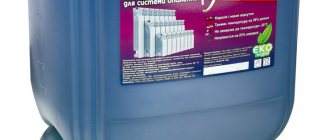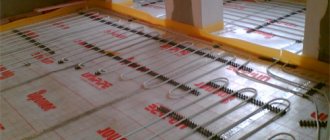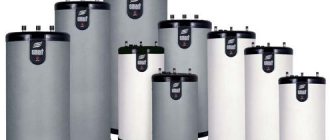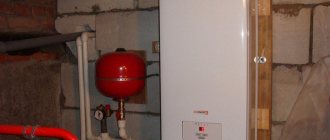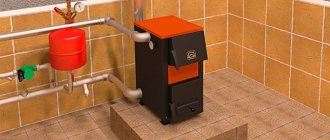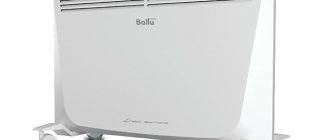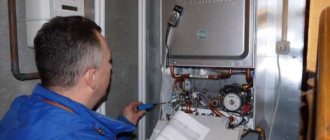Electric heating boilers are characterized by low cost, greatest comfort and ease of operation, high reliability, but heating using electricity is the most expensive.
The theoretical efficiency of all modern electric boilers is approximately 99%, that is, at maximum load, a boiler producing 9 kW of thermal energy will consume 9.091 kW of electricity. However, the efficiency of, for example, heating element electric boilers depends on the hardness of the water and the formation of scale on the heating element, so over time it can decrease to 90, 80 or even 70%. Then, more electricity will be required to heat the water to the same operating temperature.
Therefore, the efficiency of an electric boiler, first of all, depends on the principle of its operation, as well as the functionality of the control of the electric boiler: modulated power, scheduling modes, the ability to configure operation for periods of cheaper night tariffs.
Recommendations for selection
Why do people choose these devices?
Obviously, it’s all about the advantages over gas and wood-burning counterparts. Advantages of an electric heating system:
- There is no need to install a chimney to remove combustion products or connect additional ventilation. Accordingly, there are no restrictions on installation and coordination with housing and communal services authorities.
- Ease of control and programming of modes. Heating devices allow you to set the required coolant or air temperature on an external sensor.
- Possibility of using a differentiated tariff schedule. That is, during the day the cost of electricity is more expensive, at night, when peak consumption passes, it is 40-60% cheaper. If you purchase thermal accumulators as part of the boiler kit, you will save money by storing heat at night and using it during the day.
- Safety. The risk of system boiling and explosion is reduced to zero.
Heating a house with an electric boiler has the following disadvantages:
- High cost of electricity.
- Constant power surges damage the automation. The result is rapid defrosting and damage to the entire heating structure.
We list the main parameters and technical characteristics of boilers for heating systems, on which the choice depends:
- Manufacturer. It is better to consider products from well-known brands. The concerns have an extensive network of service centers that will provide quick and high-quality repairs.
- Power. Before going to the store, do not forget to carry out its correct calculation in accordance with the level of heat loss at home.
- Efficiency – no less than 95%. Electricity is the most expensive fuel, so productivity must be maximized.
- Security group. Mandatory: thermal fluid temperature limitation (up to +85 ºC), protection against overheating, dry running, pressure sensors and others.
- Number of circuits. Single-circuit boilers should be used strictly for their intended purpose, and for hot water supply, purchase separate storage boilers or indirect heating.
- Optional equipment. The piping of a high-power boiler must include a heat accumulator, a stabilizer, and if electricity is often cut off in the area, then generators running on diesel or gasoline fuel. The risk of heating system failure is reduced to zero.
To paraphrase well-known authors, we can say that electric boilers are not a luxury, but a means of heating in the harsh Russian winter.
Features of installation work
To make electric heating, you need to decide on the type of equipment to be installed. The order of actions directly depends on this. Having decided on the type of heating system, it is worth finding out how to do everything yourself, what is required for this, and how to avoid common mistakes.
Installation of infrared heated floor
To organize heating you need to purchase:
- infrared film. It is preferable to use products from leading manufacturers that fully meet regulatory requirements. Such products are distinguished by high performance characteristics and can last quite a long time;
- materials for installing a heat- and waterproofing layer;
- a thermostat with which you can control the degree of heating of the decorative coating.
After everything necessary has been purchased, installation work begins. Installation work is carried out in the following sequence:
- The base is cleaned and carefully prepared. All contaminants are removed from the floor. The base is leveled. There should be no significant protrusions.
- The thermostat is installed. The location is selected in such a way as to provide, if necessary, free access to change heating parameters;
- Thermal insulation is laid on the prepared base. To prevent the layer from shifting during installation, insulate it using construction tape;
- The infrared film is being laid. When performing work, you should follow the instructions that come with the infrared film. Laying is carried out only in open areas. There should be no film under the furniture, otherwise its operation will be ineffective;
- To avoid displacement, individual elements are connected to each other, and then the cut line is carefully isolated with bitumen tape;
- The mounted elements are connected to wires;
- The thermostat is connected;
- The installed system is monitored;
- A layer of waterproofing material is laid;
- Decorative covering is installed.
When performing installation work, safety requirements must be observed to prevent accidental injury from electric shock.
Installation of a tubular electric heater
Before starting installation work, you should decide on the installation location. For an oil heater, the place most often chosen is directly under the window, where traditional radiators are located, or on the side of the doorway. Once the location has been selected:
- Markings are applied. Places for mounting holes are marked. To do this, a heating device is applied to the base and points are marked at the location of special elements intended for fixation on the fasteners. The final result largely depends on the quality of this stage;
- According to the mark made, mounting holes are formed;
- Fasteners are screwed into the drilled holes. Most often, fasteners are supplied with the heating device and have the shape of a hook. If this is not included in the package, you can always purchase everything you need to complete the work at your nearest hardware store;
- The device is hung on prepared fasteners. Its performance is checked. The operating mode is regulated. If the device does not include a special sensor that allows you to adjust its operating mode, connect an external device. With its help, you can set the temperature change within a strictly specified range.
Boiler installation
If an electric boiler is used for electric heating in a wooden house, you must first decide on the location of its installation. The choice of location depends on the selected heater model and its characteristics. Double-circuit models allow you to provide not only heating of the living space, but also organize hot water supply. They are installed in such a way that there are no difficulties connecting to water. Most often, a bathroom or kitchen is chosen for this purpose.
Once the location for installing the heater has been selected, a detailed diagram is drawn up, which determines the position of each element of the system. After this, the panels are installed, which will be used to place the machines. Each room should have its own machine to protect the system from negative factors. The wiring is done taking into account the placement of the boiler and other devices. Equipment that will be used for heating is being installed. All elements of the system are interconnected. Their spatial location and performance are monitored.
A test run is being carried out. If necessary, existing deficiencies are eliminated and optimal operating modes are set to create comfortable conditions in the room. If everything was done correctly, the room should become warm fairly quickly. Warming up to the optimal temperature can be done at maximum mode. Then the intensity of the heat flow can be slightly reduced.
Video instructions for installing the economical Galan boiler
The undeniable advantage of such a boiler is its fast heating. high fire safety, no connectors. which often cause leakage. At the same time, the boiler operates even at low power, which other types of boilers cannot do. Unlike conventional heating elements, scale cannot be deposited on such boilers
And what is very important, the performance of such a boiler does not decrease over time. And their service life reaches 25 years or more
Organizing heating using a gas boiler is considered the most economical and convenient. However, for people living in areas where there is no central gas pipeline, they have to look for other options. In particular, a solid fuel or electric boiler, and more and more people are leaning towards the latter. This is due to the fact that in the first case it is necessary to purchase fuel and be able to heat it correctly, because with a small amount of firewood or poor coal, this is a real science.
The only disadvantage of electric heating is the dependence on energy supply and increased power, which also causes increased costs. Therefore, the question arises, what is the most economical electric heating boiler? The household product category includes models with a power of 3-60 kW, although in most cases it is no longer practical to install boilers larger than 10 kW due to possible network overload. Thinking about how to choose the most economical electric heating boiler, we can say that a power of 5 kW is quite enough to heat an area of 80 square meters, i.e. for a large three-room apartment or an average house.
People who have the opportunity to choose between several methods of organizing heating involuntarily have a question: which boiler is more economical - gas or electric? We can definitely say, assessing current energy prices, that gas heating will be much more economical. If an exclusively electric option is considered, then it is necessary to highlight several ways to increase its efficiency:
• purchase a modern, more expensive model with a built-in thermostat, which allows you not to “overheat” the room when weather conditions improve;
• ensure high-quality thermal insulation of the house by making an external coat, installing dense sealants on windows and doors, etc.;
• install a two-zone meter that calculates the electricity consumed at night at a tariff that is 5 times less;
• organize a system with forced circulation of coolant.
Reviews of economical household electric boilers: advantages and disadvantages
| Advantages | Flaws |
| Compact sizes. Models with a steel square case are much smaller than gas models. Electrode boilers can be slightly larger than the main heating system in the house. | High energy consumption and, as a result, the most expensive heating costs. Therefore, even the most energy-saving boilers can hardly be called economical. According to practice and reviews from owners, heating even a small house with an area of 80 m2 with electricity costs 9-12 thousand rubles. per month. To use cheap night rates, you need an appropriate meter. |
| High efficiency and heating rate of coolant | Models with a power of more than 5-6 kW require a three-phase power supply (380 V). |
| Easy to install and operate. You can install an electric boiler without any special skills; moreover, it does not require a chimney, ventilation system, or boiler room. Operation and maintenance require minimal attention. | When used as the main heating equipment, it is completely dependent on power supply. For stable operation in domestic conditions, a stabilizer and a UPS or generator are desirable |
| Electric boilers are absolutely environmentally friendly because, unlike other types, they do not emit any substances during operation | Powerful models create a significant load on the electrical network of the house. Therefore, they require high-quality and serviceable wiring. |
| Absolutely silent operation | |
| Availability of both single-circuit and double-circuit models (providing heating and hot water supply). Many models can be used in underfloor heating systems. | |
| Extremely low cost of most models |
What does an electrode boiler provide?
The very idea of an electrode boiler is this. to refuse the use of heating elements. If you now look at the diagram of an electrode boiler, you will see that electric current passes through the coolant from the electrode, which is supplied with voltage to the body of the boiler, which is also a conductor.
Of course, any competent electrician will say that there is no real movement there.
But for us it doesn’t matter at all now
What is important is that losses in this case are minimized. And thanks to this, the electrode boiler has an efficiency of up to 97 percent
Where do these same 3 percent of 100 go, I wrote to you a little higher.
It is important for us that, all other things being equal, an electrode boiler will consume slightly less electricity than a classic boiler with heating elements. This time
Secondly, the process of heating the coolant itself occurs faster, because when the electrode boiler operates, the entire volume of water is heated at once, and not just the layer next to the surface of the heating element.
But in such a scheme there are not only advantages, but also disadvantages. You will read about them below, in the “Reviews” section.
Should they be used for heating a private home: we analyze known statements and misconceptions
- An electrode boiler is much simpler and cheaper to install, since there is no need for a chimney or ventilation. In addition, its installation does not require approval.
This is true, however, any electric boiler does not require a separate room for the boiler room, special wall covering, chimney organization, supply and exhaust ventilation. The process of organizing a heating system with an ion-type boiler is indeed simpler, but not as much as when using heating element analogues, which already have in their housing all the necessary components of the heating system (it is enough to connect only the supply and return).
Another example of a complete heating system with an inexpensive electrode boiler.
Regarding coordination, it all depends on power. Any electric boilers with a power of more than 10 kW require mandatory approval from the Energonadzor services. It is also important to understand that any electric boilers with a power over 6 kW must be connected to a three-phase power supply.
- Electrode boilers have a higher efficiency, they are economical and consume 30-50% less electricity.
The efficiency of all modern electric boilers is more than 99%, so such statements are just a marketing technique or a comparison with extremely old models that have not been on sale for at least several years.
However, there is also some truth in the statement, since due to the formation of scale when using hard water as a coolant, the efficiency of heating element models decreases over time to 90 or 80%: heating the coolant through a layer of scale requires more time and energy consumption. The efficiency of ion boilers remains stable for a long time.
Also, the functionality of the automation seriously affects the efficiency. The automation of ion models is simpler and inferior to heating elements, where models in the mid-price segment and above have energy-saving night modes, the ability to program the operating mode for a week in advance, etc. The problem can be solved using a room thermostat costing 2,000-4,000 thousand rubles, but again, these are additional costs that offset the main advantage of electrode boilers - low cost.
Wall-mounted room thermostat for electric boiler.
- The reliability and service life of electrode models is higher.
With proper operation that meets the requirements, this is partly true, since electrode boilers have the simplest possible design and any malfunction in the first 12-15 years of operation is rare.
At the same time, the only vulnerable part of heating element models is the heating element itself - the heating element. When using low-quality coolant, it must be replaced after 3-5 years, when using prepared, purified and softened coolant - up to 8-10 years.
- Ion-type electric boilers are safer.
In an emergency, this is indeed justified by the principle of operation, since in the event of a coolant leak or power outage, the electrodes will simply stop working. When power is applied, they resume operation again without human intervention. Heating element models without overheating protection will not stop working if the coolant leaks, which will lead to destruction.
But the fact is that today even many budget heating electric boilers have protection against overheating, a mode to prevent freezing, and protection against blocking the circulation pump. Therefore, this is an extremely controversial statement.
Efficiency and selection criteria for energy-saving electric heating boilers
- Price
Most electrode models cost between 4-9 thousand rubles, while the cost of heating elements ranges from 19 to 29 thousand for the most common models in the middle price segment.
The low price of ion-type boilers is indeed a significant advantage, but is often overestimated by the buyer. It is worth considering that to organize the system, you will have to separately purchase an expansion tank, a safety group, a circulation pump and other components already present in the housing of models with a tubular electric heater. And this is another 5-10 thousand rubles. To achieve greater comfort and savings, a functional electronic thermostat is also needed - another 2-4 thousand rubles.
Difficulties in operation
Branded coolant from the manufacturer Galan. At the time of writing, the cost of such a canister is about 2,200 rubles.
- Proper operation in accordance with the requirements implies the use of high-quality coolant with a balanced chemical composition and all the qualities of the electrolyte. Manufacturers recommend using liquids specially prepared for these purposes that have good ionization, sufficient heat capacity and anti-corrosion properties. It is possible to pour ordinary tap water into the heating system, but this usually leads to a decrease in efficiency and rapid corrosion of all metal lines of the heating system. In addition, over time, any coolant loses its properties and requires replacement after 3-4 years, which also causes additional hassle and expense.
- As we have already mentioned, the effect of electric current on ferrous metals and stainless steel significantly accelerates the corrosion process, which reduces the life of the heating system. Therefore, in conjunction with electrode boilers, it is generally not recommended to install steel or cast iron radiators - only aluminum or bimetallic ones. Otherwise, the lifespan of radiators is literally reduced several times.
- The phases of the electrical network are connected to the electrodes, and zero is connected to the body of the electric boiler, so reliable universal grounding is required and it is not recommended to limit yourself to installing an RCD. If the grounding is poor, dangerous potentials may appear on pipes and batteries. In addition, it is necessary to ensure the quality of the wiring in the house, since high-power equipment creates a serious load on the electrical network and causes voltage fluctuations. However, this is not a feature of ion electric boilers, but in general of any electrical equipment with a power of 4-6 kW.
To summarize: if you are not ready for additional installation work and operating features of electrode boilers, it is better to pay an additional 20-30% of the cost and choose a heating element electric boiler, which is what we recommend doing. Today they occupy about 90% of the electric boiler market. But with a competent approach, there is also a choice in favor of ion-type boilers, the advantages and disadvantages of which are summarized below.
Alternative sources of electrical heating
Sometimes, for peak loads, it is advisable not to increase the boiler power, but to install additional sources of electrical heating. They may be:
Warm floors made of heating cable or infrared mats for the kitchen, bathroom and other rooms of a private home.
Infrared heaters installed under the ceiling and heating horizontal surfaces: floors, furniture. This creates a feeling of warmth even at low temperatures in the house.
Convectors. They can be installed in areas of the house that are used periodically: office, library, gym, and turned on as needed.
Thermal curtains installed above the entrance or balcony door and allowing to cut off the wave of cold air.
When installing additional heating sources, the nominal temperature on the boiler control panel can be set 3-5 degrees lower, which will ultimately lead to savings.
Heating with electricity is not a cheap method, but it is reliable and fully controllable using a preset program. Choosing a suitable boiler and then using it wisely will allow you to enjoy heat in a private home at a relatively low cost.
https://youtube.com/watch?v=2M_qMJoszUs
Electric boilers are useful in areas without gas supply. They are lightweight, compact in size, and do not harm the environment. Such devices have a number of positive qualities:
- They are designed quite simply, provide a minimum of heat loss and a high efficiency during the heating season - about 99.5%;
- There is no need to place the equipment in a separate room of the building;
- The energy carrier does not need to be stored;
- Absolutely safe during operation: if a water leak occurs, the boiler simply turns off;
- There is no need to equip a chimney, since no substances are released into the environment during operation.
When compiling a rating of the best electric boilers intended for heating a private home, we took into account a large number of different factors - the manufacturer, productivity, the ability to provide the house with hot water, and not just heating, efficiency
In addition, when developing this top 10 ranking, we also took into account user reviews. So we can say with confidence that only the most popular and functional models were included in the review, which also have a very reasonable price
Choosing a boiler: assessing the main parameters
When purchasing a heating unit for installing an electric heating system, it is worth taking into account the area of the home, the heat-saving characteristics of the materials from which the house is built, as well as the climatic characteristics of the region.
Basic selection options:
- power;
- connection type;
- equipment;
- performance adjustment method;
- control option.
Power. The main characteristic showing the heating intensity. To determine it, use special calculators, rely on the recommendations of boiler manufacturers, or calculate it yourself.
The calculation norm is for 1 cubic meter. m of room should account for about 40 W of device power. The value must be adjusted taking into account probable heat losses
To the resulting value add 100 W per window and 200 W per entrance door.
The climate zone should also be taken into account. Table coefficients by which you need to multiply the calculated figure:
- northern regions – 1.8-2;
- central zone – 1.2-1.4;
- southern area - 0.7-0.9.
When choosing an electric boiler for a cottage or private house, the final value should be multiplied by 1.5. A reserve of 50% is needed to cover heat costs through the ceiling and walls.
Connection type. Electric heaters are divided into single-phase, operating from 220 V, and three-phase - requiring a recharge of 380 V
This parameter depends on the boiler power. For devices up to 9 kW it is possible to connect to a single-phase network. High-power units require a 380 V network supply. A separate three-phase network will require permission.
Equipment. There are two options:
- basic equipment - purchase of one boiler, the remaining necessary components will have to be purchased separately;
- mini-boiler - a complete boiler.
The second option is preferable. Purchasing and installing all components separately will cost more than purchasing and commissioning a complete boiler.
Power control method. The ease of use of the device depends on this parameter. Stepwise and smooth adjustment is possible. The first option is used in boilers with several heating elements.
The downside of the technology is the limited choice of capacities. To more accurately regulate the temperature in the room, use valves and thermostats on radiators
Smooth power selection is preferable. Its advantages: obtaining a more comfortable microclimate, energy efficiency. In budget versions of low-power boilers, there may be no performance adjustment at all.
Control methods:
- Mechanical. Such boilers are affordable, but the accuracy of temperature control is insufficient. In addition, mechanical systems are loud - clicking sounds are heard when shifting. This option is suitable for boilers operated in non-residential premises.
- Electronic. The control system is more convenient and economical. The use of electronic thermostats and thermostats allows you to save up to 20% of electricity. The downside is the high cost.
It is worth paying attention to the features of the case. It is better to choose a closed type boiler so that children do not have access to electrical parts.
We also recommend reading the article about arranging a boiler room in a private house. For more details, follow the link.
When an electric boiler is the best solution
Gas is not available to everyone: some settlements are located too far from the main line, and sometimes installing a gas boiler is not at all advisable. For example, for a country house that is heated several times during the winter, there is no point in purchasing an expensive set of gas equipment.
Solid fuel boilers also have a number of disadvantages: it is necessary to prepare and store fuel, and most solid fuel units cannot operate for a long time, more than 4-5 hours, on one load of fuel. In addition, they are inertial and do not allow precise temperature control. In this case, an electric boiler can solve the heating problem quickly, reliably and at no extra cost.
Advantages of electric boilers for a private home:
- easy to install, connect and maintain;
- have a high level of automation;
- Allows you to accurately set the desired temperature;
- work silently;
- no connection to the chimney required;
- do not require a separate room; most household models are mounted on the wall with your own hands.
Flaws:
- require connection to the panel with a separate cable;
- boilers with a power of more than 9 kW are produced only for three-phase voltage 380 V;
- Due to high electricity tariffs, heating costs several times more.
Minimum required power of an electric boiler for heating a house with an area of 60 m2
Electric heating element Protherm.
Compact size, minimum communications and nice design. For standard average houses in the climatic zone of the Moscow region with 2 bricks and a ceiling height of up to 2.7 m, the minimum required power is calculated quite simply: 1 kW for every 10 m2. It is also recommended to reserve a reserve of 15-20% in case of the coldest decades of the heating season and about 10% in connection with a decrease in efficiency due to the possible formation of scale on heating elements (if you choose the most common heating elements models). Total about 30% power reserve.
For example, for a private house with an area of 60 square meters, the minimum required electric boiler power is 6 kW * 1.3 = 7.8 kW, rounded up to a larger whole - 8 kW.
Simple calculations are sufficient in more than 95% of cases. For non-standard houses or climatic conditions, for example, extreme southern or northern climate zones, high ceilings, large glazing areas, etc. correction factors are taken into account. You can calculate the result taking them into account using the calculator below.
Calculator for accurate calculations
The thermal power of the heating boiler must provide the total power of the radiators, which in turn is calculated for each heated room separately, based on heat loss. Calculate the required power for each room separately and add up the indicators, the result will be the required power of the electric boiler.
Number of circuits
Construction of a double-circuit boiler.
When installing a heating boiler, you can provide your home with an uninterrupted supply of hot water, but the equipment for this must be selected especially carefully. In this case, it is necessary to make a choice between devices with one or two circuits. Single-circuit appliances allow you to organize only a heating system, since they are not designed to heat water, which is supplied to the user through taps in the kitchen or bathroom. If there is a need for this, you need to choose double-circuit gas boilers. There is a separate classification here: gas boilers are produced as wall-mounted, floor-mounted, flow-through and with large storage tanks.
Which boiler should you choose? You must first decide what functions are required from the equipment. For example, single-circuit devices are capable of supplying coolant for heated floors.
Flow-type equipment is used when almost instantaneous heating of water is required, and they pump 10-15 liters through themselves in a minute, heating this volume to the set temperature.
Double-circuit heating boilers have additional tanks with a certain capacity. They contain a volume of already hot water, but when supplied it may not always be immediately hot, and this leads to liquid consumption. Therefore, the choice must be made based on how economical and effective the equipment is, and whether it fully meets all operating requirements.
Possible options
Before you begin choosing suitable heating equipment, you need to decide on the configuration and relative arrangement of the elements of the heating system. You can achieve the desired result in different ways. Electricity can be used to heat a country house.
- intermediate coolant. The option involves installing a heating circuit within which the coolant continuously circulates. As it heats up, the pipe begins to release heat into the surrounding space, gradually warming the air to the optimal level. To implement such a scheme, a project is first developed. The characteristics of the elements of the future system and their spatial location relative to each other are calculated. The optimal location is selected;
- devices with direct heat transfer. Such equipment allows you to avoid installing a heating circuit. Heat is transferred directly from the source to the surrounding space. They are less inert compared to the previous version.
When using an intermediate coolant, special attention is paid to the order of pipe routing. She may be:
- one- and two-pipe. The latter option allows you to create comfortable conditions in all rooms at the same time. The heated coolant is supplied through one pipe, and the cooled coolant is sent to the boiler through another;
- horizontal or vertical.
Special attention is paid to the installation location of radiators. They must give off heat in full, ensuring uniform heat distribution throughout the entire interior space. The most effective and efficient layout is considered to be one that involves placing radiators around the entire perimeter of the room.
Which brand of electric heating boiler is better?
Good inexpensive electric boiler RusNIT 209M
Photo: www.teplosila.ru
Rating: 9.9 out of 10.
Average price: RUB 16,279
A compact, lightweight, domestically produced electric boiler can be called the best among inexpensive ones. The total power of the boiler is small, 9 kW, but this is enough to heat rooms with a total area of 70-90 m2 (living area of a medium-sized house or cottage, country house). At the same time, the quality and range of functions are no worse than those of expensive imported models: the work is fully automated, you can configure all the main indicators (power in three stages, air temperature, coolant temperature).
From reviews of the electric boiler RusNIT 209M:
“I’ve had an electric RusNIT in my dacha for 2 years now. Never let me down yet. The house still warms up perfectly. The good thing about it is that when you turn it on, it doesn’t immediately load the system; it distributes the load evenly across each phase. This means that, including other devices, you don’t have to worry about them burning out.
It is only important that the boiler is installed by specialists, and maintenance must be carried out on time.”
- low price
- easy installation
- smooth power adjustment
- precise temperature adjustment (+/- 0.5 °C)
- air heating within 5-30 °C
- overheat protection
- coolant presence sensor
- The housing is splash resistant.
Disadvantages of the model:
not suitable for a large house.
The best electric mini-boiler EVAN Warmos QX-18
Photo: warmos.ru
Rating: 9.8 out of 10.
Average price: 31,400 rub.
The best among powerful Russian-made electric boilers. It can safely be called a mini-boiler room: heating elements (material - stainless steel), a membrane expansion tank, and a circulation pump are assembled in one housing - all this allows you to save space during installation and reduce time. The LCD display is located at the bottom of the case. The convenient control panel is hidden behind a special door. The operation is regulated by a microprocessor, the control is fully automatic, but you can switch the device to manual mode and adjust all the parameters to your taste and needs. It works stably even with voltage fluctuations, but it is still better to connect the boiler through a stabilizer. Versatile. Suitable for heating residential premises (houses, apartments) and industrial facilities (warehouses, shops, etc.)
From reviews of the electric boiler EVAN Warmos QX-18:
“I bought Varmos and installed it at the dacha parallel to the old solid fuel one. Installation is elementary. It has been working for 5 years, no problems"
- works quietly
- built-in expansion tank 12 l
- 3 stages of power adjustment
- microprocessor control
- smooth power adjustment
- control panel at the bottom of the case
- thermostat (air temperature adjustment for 7 days)
- manual adjustment mode available
- built-in pump
- overheat protection, short circuit protection
- coolant level sensor
- pressure meter
- indication of emergency condition (light, sound).
Disadvantages of the model:
- bulky and heavy
- weak point - capacitor
- It is necessary to install a voltage stabilizer
When choosing heating equipment today, it is easy to get confused, since there is a very wide selection of models on the market. There are both simple boilers for apartments and more complex equipment designed for installation in a large country house or country house. They all differ in power, additional features, and connection technologies.
In order not to make a mistake with your choice, you need to pay attention to the rating, which clearly demonstrates which equipment is optimal in certain conditions
To choose the right boiler, you need to pay attention to the rating, which demonstrates all the advantages or disadvantages of the equipment. Choosing a gas boiler will be much easier if you know exactly what functions are needed, what estimated power can satisfy all the needs for heating and hot water supply
The rating will help you understand all the intricacies of such installations
Choosing a gas boiler will be much easier if you know exactly what functions are needed, what estimated power can satisfy all the needs for heating and hot water supply. The rating will help you understand all the intricacies of such installations.
How to choose and what to pay attention to?
When choosing an energy-saving electric boiler, experts recommend paying attention to a number of the following features::
- equipment dimensions;
- correspondence of the boiler power to the area of the heated room;
- the degree of vibration of the switched on device;
- built-in automation;
- efficiency indicators;
- the ability to control the temperature regime in individual rooms;
- the price of an electric boiler and the cost of installation services.
IMPORTANT!
If you want to purchase an affordable unit that is easy to maintain, a boiler equipped with a heating element may be your best choice.
The heating elements in it must be replaced every 5-10 years.
Those who value compactness should take a closer look at electric boilers of induction and ion type.
Availability of automation
A boiler for heating a private house must have more complex automation.
Choosing boilers is a responsible matter; you also need to pay attention to the presence of automation. It should be taken into account that any type of equipment is designed to solve a certain number of problems, its functionality will also be different
For a city apartment, it is enough to heat the water to the required temperature; some models can supply coolant to the radiators. Complex automation is simply not needed here, since the functions of the boiler are quite limited. For such wall-mounted boilers, it is enough to have automatic ignition and draft sensors. This is not enough for a country house; to ensure high functionality and safety, it is necessary to have more advanced automation.
The boiler rating here is as follows:
Boilers with automation, which allows you to adjust the heating level depending on weather conditions, are in first place. External temperature sensors and temperature indicators in the house are installed here. Such a system makes it possible to use gas economically, since when the temperature outside and in the house rises, its supply is simply reduced or stopped. The boiler turns on only when necessary, and this makes its operation very efficient.
Often in spring and autumn a situation arises when excessive overheating of the premises occurs. This happens due to the fact that the coolant is supplied to the heating system at a constant temperature, and this is not always necessary.
Therefore, you should pay attention to gas boilers that have special programmable devices that allow you to regulate heating according to a schedule. Automation includes many monitoring sensors, which, according to pre-specified data, provide control
It is advisable to use such gas boilers not only for a country house, but also for a city apartment. When rating boilers, it is necessary to put them in first place as the most efficient and capable of creating the most comfortable living conditions. But such devices are much more expensive than others, and this is also worth taking into account.
When making a choice among heating boilers, one must also take into account the presence of automation that allows hourly programming. Such automation provides a real opportunity to make settings for literally every day of the week separately. In this case, at night there will be a decrease, and during the day there will be an increase. This allows you to significantly save gas
Such gas boilers are not only efficient, but also economical, and this is very important today. When purchasing a boiler, all settings are simply immediately entered manually or selected from an already established list
There is no need to control the temperature; gas boilers independently regulate the gas supply and coolant temperature. Such equipment often tops a special rating of boilers; it is not only economically profitable, but also beneficial for health, since the air temperature at night, slightly reduced to a certain value, has a positive effect on the general state of human health.
The rating of gas boilers is a real opportunity to correctly and quickly select exactly the equipment that is optimally suited for specific conditions. According to the specified data, it is possible to determine what power is needed and under what conditions, what requirements are imposed on the equipment itself, whether automation is so important and under what conditions it is simply impossible to do without it. The following tips will help you choose equipment that will work effectively for many years, providing comfort and coziness in your home.
Conclusions and useful video on the topic
Comparison of Protherm and Stout boilers:
When choosing an electric boiler, you should pay attention to the brand name. It is better to give preference to reputable companies whose quality of products is confirmed by positive user reviews and relevant certificates. It is better to refuse unknown brands, because not only comfort, but also safety of use is at stake.
Perhaps you managed to purchase a new model of electric boiler? Please tell us which device you preferred, what guided your decision, and are you satisfied with the performance of the equipment? Leave your comments and ask questions in the block below.
EVAN S1 18
Russian single-circuit high-power boiler. This model allows you to maintain a comfortable temperature in large areas. The retail price of the boiler ranges from 21,000 to 25,000 rubles.
Specifications
The main equipment indicators include:
- base power – 18 kW;
- required voltage – 380 V;
- Efficiency at 93%;
- maximum coolant temperature – 85 0С;
- minimum temperature in the system – 30 0С;
- heating area – 180 m2;
- maximum operating pressure in the system is 0.3 MPa;
- circuit pipeline cross-section - 1 ¼ inches;
- there is no expansion tank;
- weight no more than 24 kg;
- body dimensions – 645x250x180 mm.
Model features
This boiler is characterized by its simplicity of design and ease of operation and maintenance. It does not have an automation system, but the developers took care of the possibility of connecting its elements. Thus, the boiler circuit has built-in connectors and sockets for connecting a circulation pump and an air temperature sensor, which are necessary to automatically maintain a given temperature level in the room.
The small dimensions of the model allow it to fit into any existing circuit as an additional heating element, and also to be used as an independent heat source. One circuit provides space heating, so a storage boiler must be installed to supply hot water.
All boiler elements are made of materials that are not subject to corrosion, which significantly increases the service life of the equipment. Protection systems against power surges and pressure surges ensure trouble-free operation of the model.
Boiler installation
Installation of this model does not require special skills due to the simplicity of the design. But taking into account the network voltage requirements, an autonomous heating project should be drawn up and agreed upon with the electricity distribution organization.
The pipe supply must be carried out in such a way as to ensure natural circulation of the coolant. This connection reduces the pump load and contributes to more economical operation of the equipment. The maximum coolant level in the pipeline should not exceed 30 m; with a higher value, the boiler pump will not be able to circulate it. The best option for working with developed pipeline systems is the additional installation of a circulation pump.
It is also necessary to install an expansion tank to allow the excess volume of coolant or steam to be discharged. It is not allowed to install shut-off valves at the junction of the circuit and the expansion tank. Ball valves are installed at the inlet and outlet of the circuit from the boiler for repair and dismantling work.
Clearances from obstacles are left along all sides of the body of at least 5 cm on the side edges, at least 50 cm from the floor and ceiling, as well as the front surface of the boiler with the control unit.
Flaws
The biggest inconvenience in working with this model is the need to install a large amount of additional equipment. As a result, the total cost of the system increases by 20–35%.
Prices: summary table
| Model | Type | Cost, rub. |
| EVAN EPO-7.5 | heating elementnew | 12 200-15 300 |
| Reco 8P | heating elementnew | 18 100-19 900 |
| Kospel EKCO.R2 8 | heating elementnew | 34 000-45 000 |
| Bosch Tronic Heat 3000 9 RU | heating elementnew | 41 100-43 500 |
| Galan Geyser 9 | electrode | 7 800-8 500 |
| Beryl-9 Ion | electrode | 6 000-9 500 |
| Alternative energy VIN-7 | induction | 32 000-45 000 |
Complete set of heating units
We have already listed the elements of any electric boiler in the basic, cheapest configuration. This is a heating unit, thermostat, automation with an actuator, controls and a temperature sensor.
An important nuance. In budget versions of boilers, the executive element is a magnetic starter. It clicks loudly when the heating is turned on, the sound is clearly audible in the rooms adjacent to the boiler room.
In an extended configuration, manufacturers supply electric boilers with the following equipment:
- low-noise modular contactor instead of a magnetic starter;
- circulation pump;
- membrane expansion tank for a closed heating system;
- overheating and coolant pressure sensors;
- safety group – automatic air vent, safety valve;
- circulation sensor – for induction heat generators;
- weather automatics;
- LCD display, programmer, GSM remote control module from a smartphone.
Naturally, the “fat” equipment of an electric boiler will cost much more than the “poor” one. On the other hand, you will still have to buy an expansion tank, a pump and a safety group. It is much more convenient to install the unit when these elements are hidden inside the housing.
What requirements must you meet?
If we compare an electric boiler with a gas or solid fuel one, it does not require a separate boiler room.
The device meets all safety requirements thanks to the following nuances:
- the coolant heats up without releasing hazardous combustion products;
- there is no need to install a ventilation system;
- Each design element is carefully thought out, so a person is maximally protected from accidental injuries.
This boiler is environmentally friendly . It operates from the electrical network, does not emit dangerous poisons into the atmosphere, but only provides warmth to all household members.
Manufacturing companies
Today on the market there are electric boilers from foreign companies Buderus, Kospel, Vaillant and Protherm, as well as domestic ones EVAN, RusNIT and ZOTA. Many of them have been producing their products since the last century, and some began their activities even earlier. Now more details about each:
- Buderus. This German company appeared back in the 18th century, when it founded production in the field of ferrous metallurgy. Already at the end of the next century, Buderus produced sectional cast-iron boilers, after which it became closely involved in the development and creation of various heating devices using solid, liquid fuel and electricity. Following the conquest of the native market, Buderus soon began selling its products abroad. In 2003, it was acquired by another industry giant, Robert Bosch GmbH. The parent company did not forget about the brand, they continued to develop it, and today Buderus boilers are among the highest quality on the market.
- Kospel. The first plant of this company appeared in Poland in 1990, then production was expanded to other countries. The main feature of this company’s products is the enameling of internal tanks with a special powder, making the coating incredibly durable and of higher quality than with the traditional wet method. In addition, most of the products of this brand are equipped with LCD panels, which makes operating the device much simpler and more convenient.
- Protherm. Prague manufacturer of heating equipment, founded in 1991. From the first year of operation, Protherm began developing and producing electric boilers. They were so loved by the local population that within 5 years the products appeared in stores in neighboring countries, and already in 1995 they could be found on the shelves of Russia and Ukraine. The boilers of this company are certified according to ISO 9001, which confirms the high class of their work.
- Vaillant. A family business that has been producing heating equipment for almost a century and a half. According to many tops, it is famous for its high quality materials, long period of uninterrupted operation and constant innovations in production. Most buyers note that what they like about Vaillant products is that it is almost impossible to find fault with them, their production is so well thought out and streamlined. This company has factories in China and many European countries, but it is worth noting that the products assembled in the Middle Kingdom are intended strictly for the domestic market and do not go beyond its borders.
- ZOTA. At first glance it may seem that this is a foreign brand, but products are produced under the name ZOTA. At the moment, five lines of electric boilers are produced with a capacity from 3 to 400 kW. Thanks to this, you can choose an electric boiler for any need and any facility, no matter whether it is a residential or industrial premises. According to reviews, ZOTA products are highly energy efficient and easy to use.
- EVAN. The company was founded in 1996 and today is one of the leaders among domestic manufacturers of heating equipment. It all started with a small enterprise, which subsequently grew to enormous proportions and in 2008 became part of the NIBE Industrier AB concern. Thanks to this, the production of boilers is now concentrated not only in Russia, but also in Europe, which makes them even better and more reliable.
- RusNIT. It is a subsidiary of , which, by the way, supplies products for Roscosmos. Thus, it provides technological facilities on which Tula engineers from RusNIT realize their inventive potential. It is worth noting that RusNIT products are becoming better every year, which is noted by both domestic and foreign buyers who choose their boilers.
Finally, about energy consumption
The natural desire of a homeowner is to know how much electricity an electric boiler will consume when heating a private home. Unfortunately, actual consumption cannot be predicted. The indicator is too individual and depends on a number of factors - the degree of insulation, the temperature maintained inside, the weather.
Monthly consumption can be calculated approximately: take 50% of the estimated heat loss of the house, multiply by 24 hours and 30 days. Example: losses are 6 kW, half - 3 kW, per day 3 x 24 = 72 kW, per month - 72 x 30 = 2160 kW. Why we take ½ power: during the season the weather is not always cold, the warmer it is outside, the more often the electric boiler turns off.
An example from personal experience. A house of 100 m² is heated at night with a 9 kW electrode boiler for 8 hours, the region is southern. Over 6 months of the heating season, the electric boiler consumed 9104 kW. Average monthly energy consumption is 1517 kW, average daily energy consumption is 1517 / 30 = 50.6 kW.
Electric boilers with flow-through heat exchanger
Heat exchanger of a double-circuit boiler
In these units, water for domestic hot water is heated from an already heated coolant through an additional heat exchanger. Here the principle of operation is as follows: in normal mode, heating elements heat the coolant to the required temperature, it moves along the main circuit using a built-in circulation pump.
As soon as the hot water valve opens in the house, the flow sensor records this fact and transmits an impulse to the control unit. Then the coolant flow switches from the main circuit to the secondary circuit, giving a command to the electric drive of the two-way valve that distributes the flows. In this case, the heating of the house ceases to be supplied, since the heat generator operates on DHW.
Heating circulation pumps
A heat exchanger is built into the secondary circuit, in which two flows move towards each other, exchanging heat. That is, the coolant intensively releases heat to heat running water. As soon as the tap closes, the reverse process occurs: the controller, based on the sensor signal, gives a command to the electric drive of the two-way valve and it switches the flows back, the double-circuit electric boiler again operates in normal mode.
It is advisable to use a heat generator of this type when there are 2 or 3 small hot water consumers in the house, for example, a bathroom and a kitchen. Then the performance of the flow-through heat exchanger will be sufficient. In addition, electric double-circuit boilers with a flow-through heater have other disadvantages:
- Presence of differences in hot water temperature when two consumers are used simultaneously.
- Turning off the heating system while the DHW circuit is operating begins to affect the microclimate when large rooms are heated, especially in non-insulated buildings.
- The heater requires maintenance (washing), since scale appears on the internal surfaces over time, preventing good heat transfer.
Description and principle of operation of electric heating boilers
Gas boilers are popular due to the low cost of fuel, but it is not always possible to connect them due to the labor-intensive procedure and the need for coordination with government agencies. Energy sources for solid fuel units are even cheaper, but there are many more disadvantages - they pollute, require the removal of combustion products, fuel loading, and storage space.
The listed disadvantages are absent in electric boilers, which are sometimes the only option for heating if there is no possibility of supplying gas. Moreover, electrical devices are considered not only as additional or emergency sources, but also as the main devices for the preparation of coolant. With them you don’t have to worry about ignition and other inconvenient issues associated with fuel combustion.
The most economical electric boiler should be chosen from energy-saving induction and electrode models. But we must take into account that in any case, its operation will cost approximately 2.5 times more than gas units, at best 1.5 times. Economy is considered here for situations where there are no other alternatives to electricity or if this type of energy is cheap (there are alternative sources - solar collectors, etc.).
Popular models
There is a wide selection of electric boiler brands on the market. Among the popular models you can find options in different price segments.
- Galan is a domestic manufacturer . It has three main modification options that are suitable for heating a room of any size without reducing the efficiency of the system. The "Ochag" model range varies in cost from a few to 11-12 thousand rubles, the price depending on the power of the boiler.
Installation of a heating system with an electric boiler Galan Source galanshop.eu
- Savitr is a manufacturer from Russia that produces boiler models for various tasks, with a power from 4 to 120 kW. There are three model options: Mini 3 – 8,400 rubles, Classic 4 – 9,900 rubles, Optima 4 – 19,000 rubles.
- Ukrainian manufacturer EnergoLux provides boilers with additional functions, including: wireless temperature sensors, various programs and climate control. There is a peculiarity - individual radiators are independent devices for different rooms and rooms. Cost of models: Premium-1500PU/12 – 9400 rubles, Elite-1500PUT/15 – 12200 rubles.
- Polish brand KOSPEL-EKCO . The model range has different functionality and power. The cost varies from 27 to 40 thousand rubles.
- SAV is a model range with increased power and efficiency of 99%. The price varies depending on the power level, from 30 to 120 thousand rubles.
Typical connection diagram for a wall-mounted induction electric boiler SAV 2.5-500 kW Source stilissimostroy.ru
There are many different manufacturers on the market for energy-saving electric boilers, including those who are little known in our country. When choosing the optimal boiler model, you should take into account all factors, including the popularity of the equipment model.
It is worth noting that even well-known manufacturers have boilers with different characteristics , so it is necessary to pay attention to all the characteristics of the equipment model. The selection of the desired equipment option is based on the basic requirements and features of heating the room.
